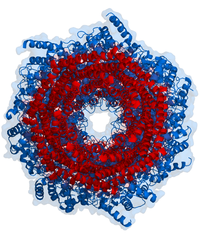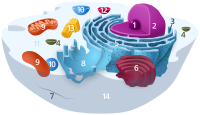
Proteasome-mediated protein degradation is enhanced by fusion ubiquitin with unstructured degron.
Sign Up to like & getrecommendations! Published in 2018 at "Biochemical and biophysical research communications"
DOI: 10.1016/j.bbrc.2018.05.088
Abstract: Methods to induce proteasomal degradation of unwanted proteins are valuable in biomedical studies and thus receive increasing attention. For efficient degradation, the proteasome requires both a ubiquitin tag, which delivers substrates to the proteasome, and… read more here.
Keywords: degradation; proteasome mediated; degron; ubiquitin ... See more keywords

Structural insights into SMCR8 C-degron recognition by FEM1B.
Sign Up to like & getrecommendations! Published in 2021 at "Biochemical and biophysical research communications"
DOI: 10.1016/j.bbrc.2021.04.046
Abstract: C-degrons play critical roles in targeting the receptor proteins of Cullin-RING E3 ligase complexes to initiate protein degradation. FEM1 proteins, including FEM1A, FEM1B, and FEM1C, act as the receptors to specifically recognize Arg/C-degrons to enable… read more here.
Keywords: insights smcr8; degron; smcr8 degron; structural insights ... See more keywords

Recognition of the Diglycine C-End Degron by CRL2KLHDC2 Ubiquitin Ligase.
Sign Up to like & getrecommendations! Published in 2018 at "Molecular cell"
DOI: 10.1016/j.molcel.2018.10.021
Abstract: Aberrant proteins can be deleterious to cells and are cleared by the ubiquitin-proteasome system. A group of C-end degrons that are recognized by specific cullin-RING ubiquitin E3 ligases (CRLs) has recently been identified in some… read more here.
Keywords: diglycine end; degron; end; end degron ... See more keywords

N-Degron Pathways in Plastids.
Sign Up to like & getrecommendations! Published in 2019 at "Trends in plant science"
DOI: 10.1016/j.tplants.2019.06.013
Abstract: Protein amino (N) termini are major determinants of protein stability in the cytosol of eukaryotes and prokaryotes, conceptualized in the N-end rule pathway, lately referred to as N-degron pathways. Here we argue for the existence… read more here.
Keywords: degron; degron pathways; pathways plastids;

Repurposing the Damage Repair Protein Methyl Guanine Methyl Transferase as a Ligand Inducible Fusion Degron.
Sign Up to like & getrecommendations! Published in 2022 at "ACS chemical biology"
DOI: 10.1021/acschembio.1c00771
Abstract: We successfully repurpose the DNA repair protein methylguanine methyltransferase (MGMT) as an inducible degron for protein fusions. MGMT is a suicide protein that removes alkyl groups from the O6 position of guanine (O6G) and is… read more here.
Keywords: fusion; degron; repurposing damage; guanine ... See more keywords

Molecular basis for ubiquitin ligase CRL2FEM1C-mediated recognition of C-degron
Sign Up to like & getrecommendations! Published in 2021 at "Nature Chemical Biology"
DOI: 10.1038/s41589-020-00703-4
Abstract: Proteome integrity depends on the ubiquitin–proteasome system to degrade unwanted or abnormal proteins. In addition to the N-degrons, C-terminal residues of proteins can also serve as degradation signals (C-degrons) that are recognized by specific cullin-RING… read more here.
Keywords: arg degron; terminal arginine; degron; molecular basis ... See more keywords

Crystal structure of the Ate1 arginyl-tRNA-protein transferase and arginylation of N-degron substrates
Sign Up to like & getrecommendations! Published in 2022 at "Proceedings of the National Academy of Sciences of the United States of America"
DOI: 10.1073/pnas.2209597119
Abstract: Significance N-degron pathways target proteins for degradation by recognizing their N-terminal residues. A destabilizing N-terminal Arg residue can be generated by a proteolytic cleavage of a protein either directly or after N-terminal arginylation of the… read more here.
Keywords: structure ate1; degron; protein; transferase ... See more keywords

The Cys-N-degron pathway modulates pexophagy through the N-terminal oxidation and arginylation of ACAD10.
Sign Up to like & getrecommendations! Published in 2022 at "Autophagy"
DOI: 10.1080/15548627.2022.2126617
Abstract: In the N-degron pathway, N-recognins recognize cognate substrates for degradation via the ubiquitin (Ub)-proteasome system (UPS) or the autophagy-lysosome system (hereafter autophagy). We have recently shown that the autophagy receptor SQSTM1/p62 (sequestosome 1) is an… read more here.
Keywords: cys degron; degron; sqstm1 p62; degron pathway ... See more keywords

Degradation of integral membrane proteins modified with the photosensitive degron module requires the cytosolic endoplasmic reticulum–associated degradation pathway
Sign Up to like & getrecommendations! Published in 2019 at "Molecular Biology of the Cell"
DOI: 10.1091/mbc.e18-12-0754
Abstract: Protein quality mechanisms are fundamental for proteostasis of eukaryotic cells. Endoplasmic reticulum–associated degradation (ERAD) is a well-studied pathway that ensures quality control of secretory and endoplasmic reticulum (ER)–resident proteins. Different branches of ERAD are involved… read more here.
Keywords: endoplasmic reticulum; membrane; degradation; degron ... See more keywords

HYPK promotes the activity of the Nα-acetyltransferase A complex to determine proteostasis of nonAc-X2/N-degron–containing proteins
Sign Up to like & getrecommendations! Published in 2022 at "Science Advances"
DOI: 10.1126/sciadv.abn6153
Abstract: In humans, the Huntingtin yeast partner K (HYPK) binds to the ribosome-associated Nα-acetyltransferase A (NatA) complex that acetylates ~40% of the proteome in humans and Arabidopsis thaliana. However, the relevance of HsHYPK for determining the… read more here.
Keywords: acetyltransferase; nonac degron; degron; activity ... See more keywords

Selectivity among Anti-σ Factors by Mycobacterium tuberculosis ClpX Influences Intracellular Levels of Extracytoplasmic Function σ Factors
Sign Up to like & getrecommendations! Published in 2019 at "Journal of Bacteriology"
DOI: 10.1128/jb.00748-18
Abstract: The ability of Mycobacterium tuberculosis to quickly adapt to changing environmental stimuli occurs by maintaining protein homeostasis. Extracytoplasmic function (ECF) σ factors play a significant role in coordinating the transcription profile to changes in environmental… read more here.
Keywords: extracytoplasmic function; mycobacterium tuberculosis; anti factors; tuberculosis ... See more keywords